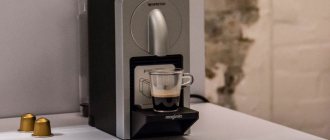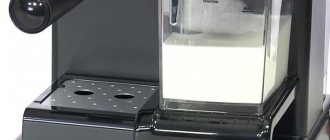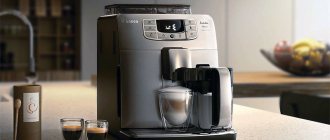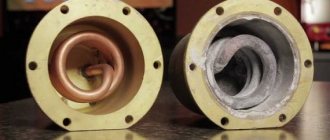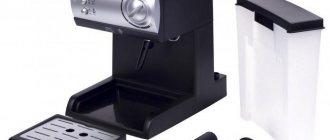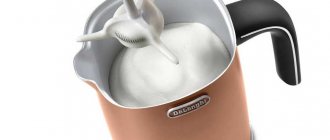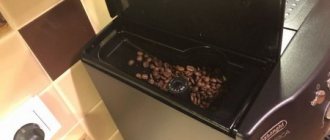In May 2021, not just a new Philips coffee machine entered the Russian market, but an entire platform, which at the time of writing this review included 12 modifications in formally three series: Series 1200, 2200 and 3200.
As you can easily guess even just from the digital designations of the series, this is all the initial class of grain machines, divided into different sublevels, depending on the presence of some additional functions and/or recipes, equipment. This is true:
Philips Series 1200 is available in two modifications:
- Philips EP1000 . The coffee machine becomes the most basic model of the brand, completely devoid of a cappuccino maker. Its prototype was the Philips HD8648. It can only prepare espresso and lungo of different sizes. Moreover, at first glance it seems that there are 4 feed buttons, but the bottom row is just double portions. The Philips EP 1000 can neither froth milk, even manually, nor dispense hot water. Taking into account the price at the level of the next modification (at the time of release it is 25-30 thousand rubles), I think it is not worthy of attention in principle. Exception: if for some strange reason you need a coffee machine without a cappuccino maker. Of course, there is no AquaClean water filter included in the kit (read my attitude towards all such filters in the profile material).
- Philips EP1220 . It is already equipped with a manual cappuccino maker with panarello, but also comes without an AquaClean water filter. Two buttons to start drinks: “espresso” and “coffee” (i.e. lungo). Plus below them are buttons for steam and hot water from the cappuccino maker. This also includes PHILIPS EP1224/00 (gray) and EP1222/00 (red), which differ from the black EP1220/00 only in color.
Philips Series 2200 is represented by six modifications, but in reality there are two models:
- Philips EP2020/EP2021/EP2224 - the same as the EP1220, only with an AquaClean filter included (everything below is also with AquaClean). They differ from each other only in shades of color. Moreover, they are all dark, only one is glossy, the other is matte, and the third is slightly lighter.
- Philips EP2030/EP2035/EP2231 – modifications with an automatic LatteGo cappuccino maker in the form of a 250 ml jug. Drink start buttons: “espresso”, “coffee” (i.e. lungo), “cappuccino”, “hot water”. There is no separate setting for the volume of milk, only the choice of the total volume of the drink. It is important. The modifications differ from each other, as in the case above, only in color nuances.
Philips Series 3200 is represented by four modifications, but in reality these are also two models:
- Philips EP3221 is the flagship of the platform in the version with a manual cappuccino maker. Yes, you need to froth the milk manually, but here is the largest set of black coffee recipes: “espresso”, “coffee” (i.e. lungo), separately “lungo” (this is just another cell for programming), “Americano” ( special mode, first the machine pours espresso, then adds hot water from the same nozzles). Plus, the panel has a separate temperature setting that can be changed at any time - only 3 degrees. All other modifications also have a brewing temperature setting, but it is the same for all modes and can be changed with the machine turned off through the combination: hold down the portion volume selection for a few seconds, set the degree with the same button, press “start”.
- Philips EP3241/EP3243/EP3246 are the flagships of the platform in the version with an automatic LatteGo cappuccino maker. Drink start buttons: “espresso”, “coffee” (i.e. lungo), “Americano”, “cappuccino”, “latte macchiato”, “hot water”. There is a separate setting for milk volume. The modifications again differ from each other only in the nuances of color. EP3241 – black, EP3243 – white with dark and silver elements (looks elegant!), EP3246 – black with silver elements (in the photographs in the review it is mainly this modification).
In total, we actually have 4 models in different colors. Two – with a manual cappuccino maker, a simpler one, with two recipes, and a more sophisticated one, with four and a separate temperature setting on the control panel.
And two models with automatic LatteGo cappuccino maker. One is simpler, with one button for milk and setting only the total volume of the drink, and the second, with two milk recipes and a separate setting of proportions.
I think you can interpolate the information below for simpler modifications, but I tested the flagships with LatteGo.
What it is?
The drip coffee maker has its own history. The device, which made coffee by straining hot water through ground powder, was first offered to consumers in 1800. The inventor of the method is considered to be Jean-Baptiste de Bellois, a church minister and Archbishop of Paris.
This invention was repeatedly modernized, redesigned, and presented in different countries. But the cooking principle remained the same. Thanks to the evolution of electrical devices, the drip coffee maker has its own heating source. A modern machine is presented in the form of an electric device with a heater, where hot water flows through a filter with ground coffee and enters the tank. The strength and aroma of the drink is ensured by the slow passage of water through the coffee, due to which it has the taste and aroma of ground beans.
What drinks can you prepare?
The basis of all drinks - espresso - the Philips Saeco HD 8323 Poemia coffee maker prepares with dense, high foam. Users have no complaints about this. The aroma of the beans is fully revealed if you use clean filtered water. Manufacturers recommend buying bottled water to reduce scale formation. Essential oils dissolve better in soft liquids.
In addition to espresso, you can prepare:
- Cappuccino using panarello and hot steam.
- Latte by adding more milk.
- Macchiato by placing whipped milk foam on top of the espresso foam.
- Drinks with alcohol, which is added to ready-made espresso.
Cold espresso drinks can be made after the base has cooled. This is ice cream with ice cream, cocktails with coffee, cold milk and additives in the form of bananas and berries.
Step by step process on how to make espresso
To prepare espresso on the Philips Saeco Poemiya:
- Pour and compact the coffee into the cone. The amount depends on the water settings.
- Insert the horn into the cooking port and turn until it clicks.
- Place one large or two small cups.
- Turn the tap in the center to the left.
- Wait until a sufficient amount of coffee has flowed out and turn the tap back.
For pod coffee, a filter is inserted into the horn. If you look, there will be a steam icon on the right. It is needed to make cappuccino.
How to make cappuccino
You can froth the milk when the espresso is ready and cooling, or first froth the foam and place a mug of milk for espresso. To do this, pour any milk into the container; before doing this, you need to turn the central tap to the right so that the machine begins to generate steam.
On the right side of the panel there is a tap that releases hot steam. You need to use it carefully so as not to burn your hand:
- Direct the pannarello tube onto the drip tray.
- Turn off the tap and release some water and steam.
- Place a container of milk under the tube, immersing it at least 2 - 3 cm.
- Use your free hand to control the flow of steam, while simultaneously turning the mug so that all the milk heats up and foams.
After whipping, you need to lightly tap the container on the table so that large air bubbles burst and the foam becomes homogeneous.
How to change strength settings
You can make your coffee stronger and richer in the following ways:
- Add more ground beans and pass the standard amount of water through them.
- Put in the usual portion, but turn off the water supply tap faster. In this case, the result may be a ristretto.
Since the Saeko carob coffee maker, according to the instructions, is semi-automatic, you can choose how much water and coffee to put in in the morning or at lunch. There is only one minus - you need to wait until the water starts flowing out and stop it in time.
Important! If the espresso preparation time has increased, the coffee maker must be descaled using professional cleaners or citric acid.
What does it consist of?
The devices are produced by different manufacturers, but their basic elements are the same. What is the structure of a drip coffee maker? The device consists of:
- cold water tank (usually it is non-removable and located at the back);
- tank or boiler where heating is performed;
- heating element;
- a funnel or filter for ground coffee (the funnel in some devices is removable, and the filter is autonomous, can be disposable and for regular use);
- containers for ready-made coffee (made in the form of a flask, coffee pot).
The instructions for the drip coffee maker indicate the design features of the device. The rules for using the device and making coffee are also indicated there.
Series 3000
The series models are equipped with a strength regulator and 5 grinding levels. Cappuccino is brewed by simply pressing a button, but you can also froth the milk separately.
HD8829
An automatic coffee machine with 5 grinding modes and working only with whole beans. The coffee grinder container holds 250 g, and the waste container is designed for 15 servings.
Advantages:
- high-quality automatic cappuccino maker;
- tasty coffee;
- easy cleaning.
Flaws:
- only two modes for adjusting the strength of the drink;
- complex setting of grinding degree;
- high water consumption;
- insufficient heating.
Reviews
| Inna Istomina | Mikhail Smirnov |
| “It makes delicious coffee, there are several options for the drink, but it consumes a lot of water, since it constantly automatically rinses the components.” | “For its price, this is a very high-quality device, the grinding type can be adjusted, compact size, and a large water tank.” |
HD8827
A compact and capacious coffee machine, which allows you to quickly prepare high-quality espresso from beans, is equipped with a manual cappuccino maker.
Advantages:
- small size;
- simple controls;
- aesthetic appearance;
- easy to clean.
Flaws:
- only 125 g of the declared 250 are placed in the bean compartment;
- unreliable handle of the water tank.
Reviews
| Igor Mokshin | Maria Vasilyeva |
| “The machine does not take up much space, has a nice design, is easy to clean, and easy to set up. During operation, a slight crunch is heard, but, according to reviews, this occurs in all such devices.” | “The coffee turns out rich and tasty, it’s convenient to fill the water from above, and the tank for it is also spacious.” |
Characteristics of models
| Model | HD8829 | HD8827 |
| Number of groups | 1 | 1 |
| Coffee type | Grain | Grain |
| Volume, l | 1,8 | 1,8 |
| A heating element | Boiler | Boiler |
| Ultimate pressure, bar | 15 | 15 |
| Power, W | 1850 | 1850 |
| Pressure gauge | No | No |
| type of product | Espresso, cappuccino | Espresso, cappuccino, lungo |
| Settings | Strength and portions of boiling water | Strength, wetting before cooking, portions of boiling water |
| Making cappuccino | Yes (automatic) | Yes (manual) |
| Auto power off function | Eat | Eat |
| Coffee grinder | Eat | Eat |
| Grinding levels | 5 | 5 |
| Weight, kg | 7,2 | 7,2 |
| Price, r | 36999 | 27990 |
Principle of operation
It is important to know not only how to use a drip coffee maker, but also about the principle of operation:
- Water is poured into a reservoir, from which it goes into the boiler.
- The water is heated in the tank and rises up the tube.
- Drop by drop, it enters through the thickness of the coffee powder and penetrates into the lower compartment.
- After heating and dripping water through the filter, the coffee is considered ready.
The coffee grounds will be in the filter and will not stain the cup. The area where the reservoir with the drink is located will heat and maintain the temperature of the coffee. Although coffee makers from different manufacturers are similar, they still differ in design, volume, materials and power. The difference is observed in the functions: auto power off, timer, indication, control.
The main thing for all these cars is a new platform
Let me clarify once again - we are looking at initial coffee machines that are lower in the company’s model range than Philips Series 4000, Series 5000 and all Saeco. In fact, this is a replacement for the already really outdated Series 2000/2100, which originate from the Saeco Xsmall, and at the same time the Series 3000. The Xsmall was and still remains a very compromise machine, which I recommended for purchase only with the most limited budget; it used to come across for 15,000 rubles There is no point in buying it more expensive due to limitations in functionality and convenience.
Many bugs have been corrected in the new platform. For example, now all containers have normal volumes: for water - 1.8 liters, for grains - 275 grams, for cake - 15 servings. And the drip tray is now of normal, medium size, it does not need to be drained every 5 cups. The water tank comes from the front, like the Xsmall, but from the other side, on the right. In this regard, the cars are very similar to competitors from DeLonghi.
The brewing unit is used exactly the same as before, as on all other machines of the concern. Here is a photo next to the teapot from Saeco PicoBaristo Deluxe - only the nozzle on the inlet pipe is different:
The infuser of the new Philips compared to the charger from Saeco SM5570 (right).
But the location has changed interestingly. Now the charger is installed behind the water tank (which must first be removed) and is located in the bowels of the coffee machine in the center. A 15-horsepower ULKA pump, a 1500 W flow-through thermoblock and a ceramic coffee grinder with flat burrs are old friends. Unless the coffee grinder has expanded the grinding fork to 12 degrees.
Setting up the fortress. It has become full-fledged (let me remind you, I am comparing this with the old Series 2000/2100). Not that there is something for every taste, but for any drink you can choose one of three levels. Yes, this is not 5, like the Philips 3100 and “higher”, but in fact, these three are quite enough, because the minimum and maximum are the same (about 7 and 11 grams of grains, respectively), there are no intermediate ones, which are no one anyway I haven’t used it, everything is usually cooked at “three” or “five” (when there is a choice of 5 levels).
Control with a choice of 3 volumes for any drink can be considered globally new.
I don’t know why they write everywhere that the Philips Series 3200/2200/1200 coffee machines use some kind of screen, and a touch screen at that. The buttons, yes, are touch sensitive, and all of them, including on/off and start/stop. But there is no screen here. All indications are LED lights. There are a lot of light bulbs, I counted 25, but as they say, quantity did not turn into quality, this did not turn them into a screen
